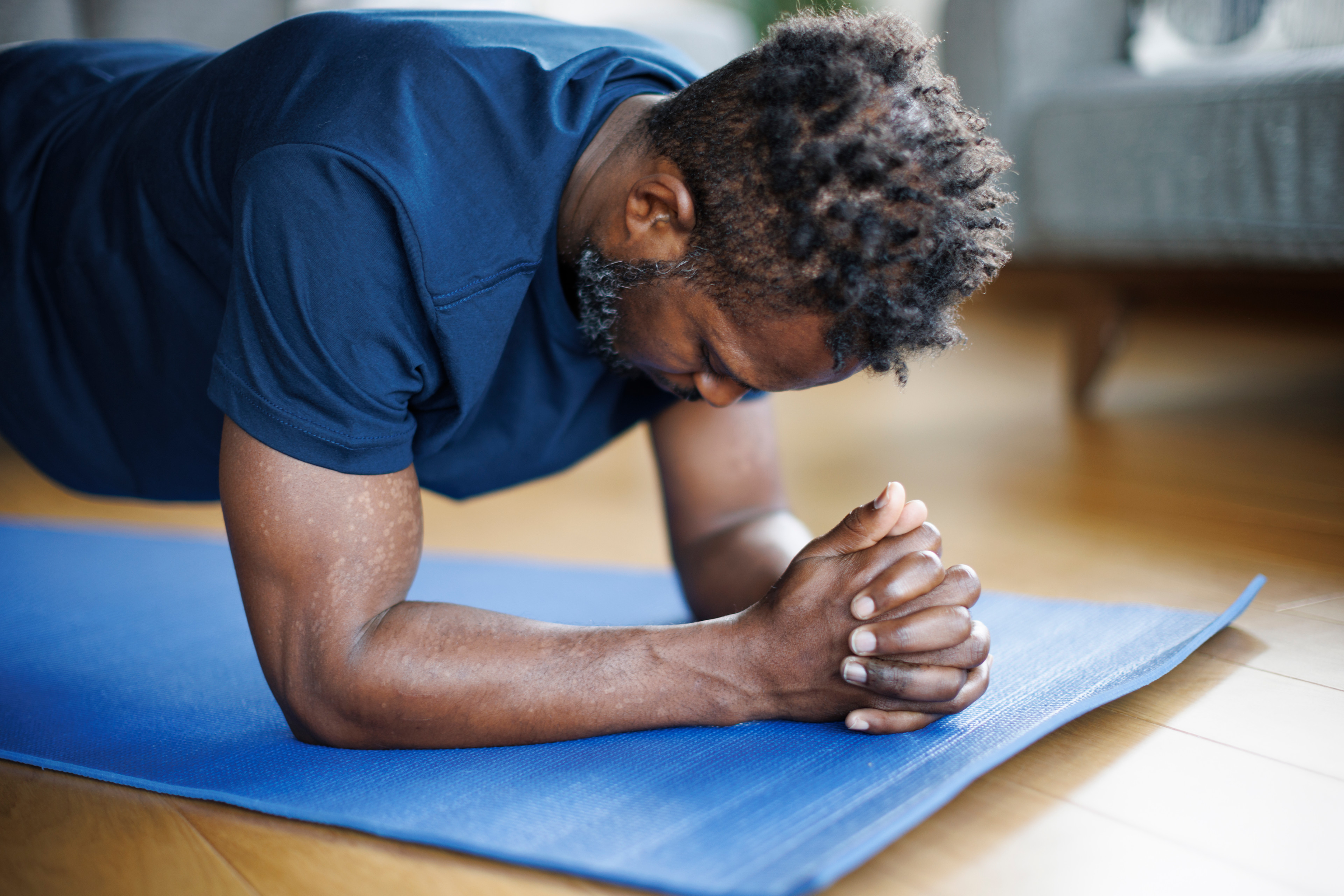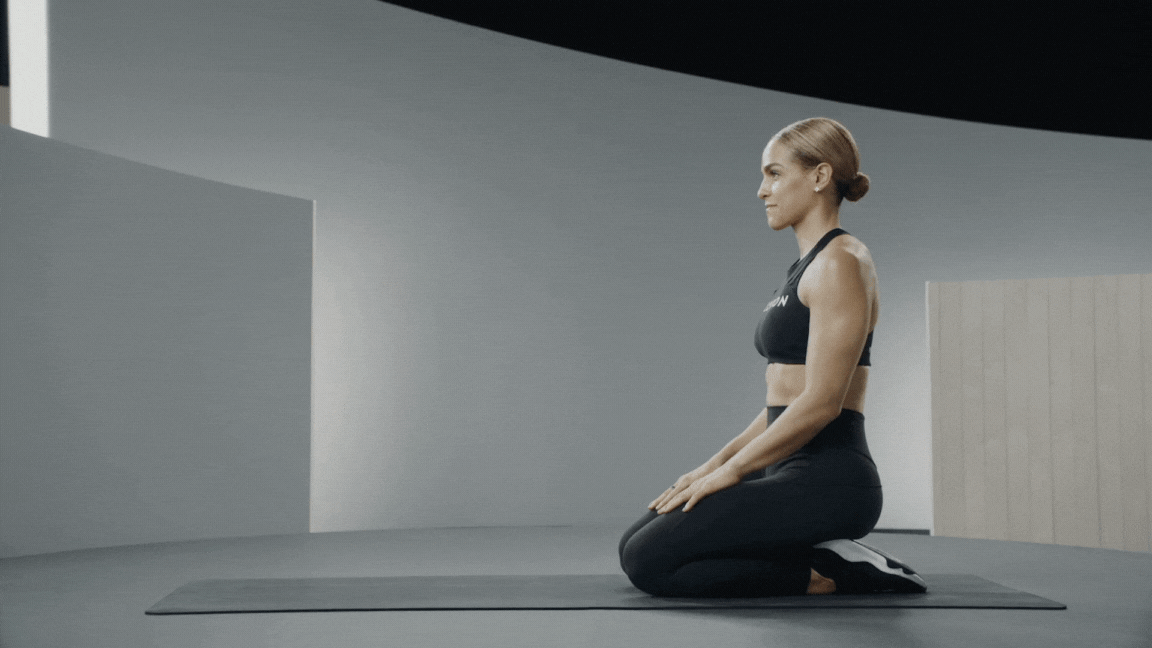
Damircudic via Getty Images
How Forearm Planks and High Planks Compare—and Which Is Better for Your Fitness Goals
Both classic variations of the plank, they differ in terms of muscle engagement, difficulty, and versatility.
By Renee Cherry•
What Is a Forearm Plank?
What Is a High Plank?
Forearm Plank vs. High Plank: Which Is Best for You?
Plank Modifications and Variations
When to Add Planks to Your Exercise Routine
At its core, the plank is a deceptively challenging exercise. Regardless of whether you opt for a high plank or assume the position on your forearms, seconds can feel like hours.
Discover more ways to reach your goals with Peloton
That said, high planks and forearm planks each have distinct pros and cons. “Planks are one of the most effective exercises for building core strength and stability, but choosing between a forearm plank and a high plank depends on your fitness goals, mobility, and joint considerations,” says Sean Carpenter, a physical therapist at Memorial Hermann Greater Heights Hospital.
Allow us to break down the differences between forearm planks vs. high planks so that you have some context to guide your future workouts.

What Is a Forearm Plank?
A plank is a static exercise that requires you to hold your body off the floor, maintaining a straight line from the top of your head through your heels as if you’re a stiff plank of wood (hence the name). During a forearm plank (also called low plank), you balance your weight on your forearms and toes, holding the position with the front side of your body facing the ground.
Here’s how to do a forearm plank, according to Peloton instructor Emma Lovewell.
Start lying face down on the floor. Prop yourself up on your forearms with your elbows directly under your shoulders, and your hands flat on the floor, in fists, or clasped together.
Tuck your toes and engage your core to lift your body off the floor, forming a straight line from your head to your heels. Squeeze your glutes, draw your shoulder blades back and down, and keep your back flat—avoid arching or sagging. Keep your neck in a neutral position by looking slightly ahead, rather than lifting your head to look forward or tucking your chin.
Hold this position for 20–60 seconds.
Benefits of Forearm Planks
Planks are an isometric exercise, meaning they involve holding a static position while your muscles are under tension. Unlike other strength exercises that require movement, planks ask you to hold still and work against the pull of gravity (and other forces) to maintain the position. Planking trains your muscles to resist excessive arching or collapsing in the lower back, stabilize against side-to-side forces (e.g., lateral shifts that occur during cutting and pivoting movements), and work to combat rotational forces (such as unwanted twisting, which is crucial for sports like golf and tennis), Carpenter says.
The payoff? “By gradually exposing the body to these forces in a controlled position, planks enhance core stability, which is the foundation for safe and efficient movement,” Carpenter says. A strong, stable core helps you move well through your day-to-day life and is also a vital step towards mastering more advanced exercises, such as sprinting, jumping, or rotating.
Planks also appear to provide a more efficient core workout compared to other abdominal exercises, such as crunches. A 2013 study published in The Journal of Strength and Conditioning Research compared muscle activation during “integration core exercises” (moves that engage the shoulders and glutes in addition to the abs, like forearm side planks and mountain climbers) with ab isolation exercises (including crunches and oblique crunches). The participants showed better core muscle engagement when performing integration exercises compared to isolation exercises.
Not to mention, the benefits of forearm planks may extend beyond improved strength and stability. One 2023 study published in the Journal of Exercise Rehabilitation focused on the benefits of performing forearm planks specifically for people in their sixties who didn’t regularly exercise. Participants who performed planks three days a week for 12 weeks not only increased their core muscle endurance but also showed signs of improved VO2 max, grip strength, and immune health. All three of those markers worsened in a control group that didn’t perform planks.
Muscles Worked by Forearm Planks
A forearm plank targets your core—which, friendly reminder, includes more than just your abs. In addition to the four muscles in your abdominals (the internal and external obliques, rectus abdominis, and transverse abdominis), your core also includes muscles in your back, pelvis, hips, and diaphragm. “The forearm plank variation effectively targets the obliques, transverse abdominis, and hip stabilizers, promoting core endurance,” Carpenter says. This exercise also requires you to engage your shoulders, back, and glutes in order to maintain total-body stability, Emma says.
Compared to the high plank, the forearm plank “places more emphasis on the core, especially the deep stabilizing muscles like the transverse abdominis,” Emma says. Your arms and shoulders can’t help out as much during a low plank, so your core is doing more work to hold your body up. “Since the body remains closer to the ground, [the forearm plank has] a more stable base, making it easier to learn proper core activation before transitioning to a high plank,” Carpenter adds.

What Is a High Plank?
A high plank is similar to a forearm plank, but your palms (rather than your forearms) serve as a base of support for your upper body. If you’re familiar with the starting position for a push-up, you’ve got the idea.
This is how to do a high plank with flawless form, according to Emma:
Start in a tabletop position, on all fours, with your hands on the floor directly under your shoulders, fingers spread for stability.
One at a time, extend your legs behind you to lift your knees off the floor and find a high plank. Your toes should be tucked and your feet together, with your body forming a straight line from your head to your heels. Avoid allowing your hips to droop or lift too high. Squeeze your glutes, push into your palms, and think about drawing your shoulder blades back and down. To ensure you’re engaging your core, gently draw your belly button toward your spine. Keep your neck in a neutral position by looking slightly ahead of your hands.
Hold this position for 20–60 seconds.
Benefits of High Planks
The benefits of high planks are very similar to those of forearm planks—i.e., you’ll still improve your core strength and stability, and reap all the perks that come with that—but straightening your arms changes things.
For example, high planks can prepare you for other exercises that may show up in your workout routine, such as push-ups and renegade rows. “A strong high plank serves as a stepping stone for more advanced exercises that integrate core stability with full-body strength,” Carpenter says. “Movements like burpees build explosive power and coordination, while fast mountain climbers increase leg strength and endurance through high-speed knee drives.” Building a strong high plank is a prerequisite for tackling those moves, and a forearm plank won’t prepare you in quite the same way.
Muscles Worked by High Planks
“A high plank activates the core while also engaging the arms, shoulders, and chest,” Emma says. “It builds upper body strength more than the forearm plank.” Research that directly compared the two agrees that high planks activate the shoulder and scapular muscles to a greater extent than forearm planks. In a 2024 study published in The Journal of Strength and Conditioning Research, participants exhibited higher muscle activation in their lower trapezius muscles (located in the upper back) and triceps (on the back of the arms) when performing high plank variations compared to forearm plank variations.
With this in mind, the high plank is a better option for those looking to develop full-body coordination and functional strength, Carpenter says.
Forearm Plank vs. High Plank: Which Is Best for You?
Just for the record, you don’t need to choose between the two. You can incorporate both high planks and forearm planks within the same routine and even the same workout.
While both forms of the plank boast similar benefits, you may choose one or the other for various reasons. For example, if you have sensitive wrists, forearm planks carry less risk. “The variation is particularly beneficial for those with wrist instability or discomfort, as it eliminates direct pressure on the hands and focuses more on core activation,” Carpenter says. As mentioned, forearm planks can work well if you’re prioritizing your core muscles, while high planks are better at firing up muscles in your shoulders and upper back.
You can also choose between a high plank or forearm plank based on how the exercise fits within the broader context of your workout. “In my classes, I consider what moves I’m doing next, or previously,” Emma says. “If there are a lot of moves on the hands, I like to give the wrists a break by doing forearm planks. Or, if my focus for the class is more towards upper body strength, then I’ll add in more high planks.” High planks also tend to be more dynamic, meaning they’re easier to transition from into movements like mountain climbers or shoulder taps, she notes.
Plank Modifications and Variations
If forearm planks and high planks aren’t within reach, you can modify either to become more beginner-friendly.
Elevated High Plank: Carpenter suggests elevating your hands onto a bench to make the exercise less difficult. This tweak places more of your body weight on your feet, so your core has less to support.
Plank Bird Dog: If you want to make a plank even harder, you can get dynamic with it. “For an added challenge, incorporating arm and leg movements—such as lifting an opposite arm and leg (like in Bird Dog) —improves coordination, balance, and anti-rotational strength,” Carpenter says. “Moving the limbs in different planes of motion further activates the obliques and transverse core muscles.”
Forearm Side Plank: Side planks are another option that allows you to focus on one side of your body at a time. “A side plank on your forearms or forearms and knees is an excellent exercise for building lateral core stability, which is crucial for athletic movements that require balance, control, and resistance against rotational as well as lateral forces,” Carpenter says. The aforementioned 2024 study also found that plank variations with fewer points of contact with the ground (e.g., two points for a side plank compared to four for a standard plank) require greater activation of the muscles in the shoulder and upper back.
High Side Plank: The high side plank is slightly more advanced than a forearm side plank, since it hits your shoulders and wrists more intensely, Carpenter says. “It also allows for greater dynamic movement, such as leg lifts or arm reaches, further challenging the core and improving balance,” he adds. “Side planks with and without leg lifts are two of the best exercises for activation of the glute muscles on the sides of the hips.”
Plank with a Stability Challenge: “Adding stability challenges, such as performing planks on a medicine ball or suspension trainer (e.g., TRX), forces the core to make constant micro-adjustments, improving overall proprioception and balance,” Carpenter says. “For those looking to target core instability, using sliders under the feet or hands dramatically increases anti-rotation demands. This forces deeper core engagement, improving balance, coordination, and eccentric control.”
When to Add Planks to Your Exercise Routine
Planks work well at the beginning, middle, or end of a workout. You can use them to activate your core during a warm-up, burn out your muscles at the end of your workout, or provide an isometric core challenge between strength sets, Emma says. She suggests starting with two to three sets and increasing the duration or difficulty (adding leg lifts, side planks, etc.) as you build endurance.
Here’s Emma’s general recommendation for slotting planks into your workout routine:
Beginner: 2–3 times per week, holding for 20–30 seconds per set
Intermediate: 3–4 times per week, holding for 30–45 seconds per set
Advanced: 4–5 times per week, holding for 60+ seconds per set or incorporating variations
Whether you complete the exercise on your hands or forearms, the benefits will be similar. “Both variations are excellent exercises for building core strength and improving movement efficiency,” Carpenter says. “Whether you choose a forearm or high plank, the key is to maintain proper form, engage the right muscles, and gradually increase intensity as your strength improves.”
Related Articles
This content is for informational and educational purposes only and does not constitute individualized advice. It is not intended to replace professional medical evaluation, diagnosis, or treatment. Seek the advice of your physician for questions you may have regarding your health or a medical condition. If you are having a medical emergency, call your physician or 911 immediately.
Featured Peloton Instructor

Emma Lovewell
Emma has spent much of her career in fitness and wellness as a professional dancer, dance coach, fitness model, personal trainer, and Pilates instructor.
Build full-body strength
Enter your email to get articles, instructor tips, and updates from Peloton sent to your inbox.
By providing your email address, you agree to receive marketing communications from Peloton.
For more about how we use your information, see our Privacy Policy.











